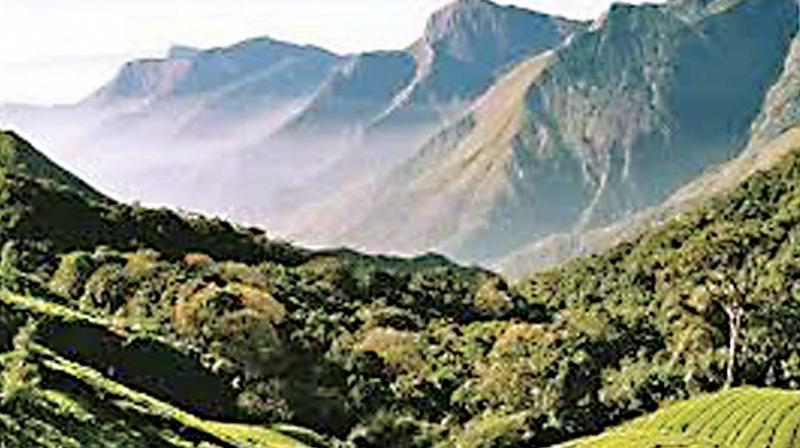Western ghats: Karnataka's slippery slope to disaster
And some studies project that at least 325 globally threatened species occur in the Western Ghats.

“Western Ghats” is a chain of mountains that run parallel to the western coast of the Indian peninsula. These Ghats are also known as the “Sahyadris” - meaning ‘the Benevolent Mountains’). It is also a UNESCO World Herit—age Site and is one of the eight “Mega - Biodiversity Hot-Spots” in the world. The Western Ghats are sometimes also called the ‘Great Escarpment of India’. These mountain ranges run North to South along the western edge of the Deccan Plateau and separates the plateau from a narrow coastal plain, called the ‘Konkan’, along the Arabian Sea. Totally thirty nine (39) properties covering national parks, wildlife sanctuaries and reserve forests were designated as World Heritage Sites. Twenty (20) of these in Kerala, ten (10) in Karnataka, five (05) in Tamil Nadu and four (04) in Maharashtra.
The Western Ghats range starts near the Songadh town in Gujarat, which is south of the Tapti river, and runs approximately 1,600 kms (990 miles) through the states of Maharashtra, Goa, Karn—ataka, Kerala and Tamil Nadu. The Ghats finally culminate at Marunthuvazh Malai, at Sw—amithope, near the southern tip of India. The Western Ghats cover almost 1,60,000 km2 (62,000 sq. miles) and form the catchment area for the complex riverine drainage systems that drain almost 40% of India. With an average elevation of around 1,200 m. (3,900 ft.) the Western Ghats block the Southwest Monsoon winds from reaching the Deccan Plateau.
The Western Ghats being one of the world’s “Mega-Diversity Hotspots” is home to over 7,400 species of flowering plants, more than 1,800 species of non-flowering plants, more than 135 mammal species, about 500 bird species, more than 175 amphibian species, 6,000 insects species and 290 freshwater fish species; it is also very likely that many undiscovered species live in the Western Ghats. And some studies project that at least 325 globally threatened species occur in the Western Ghats.
In view of this rich natural heritage, the Western Ghats Ecology Expert Panel (WGEEP), in August 2011, designated the entire Western Ghats as an Ecologically Sensitive Area (ESA) and assigned three levels of Ecological Sensitivity to its different ecoregions.
The WGEE Panel, headed by well-known ecologist Prof. Madhav Gadgil, was a committee appointed by the Union Ministry of Environment and Forests to assess the biodiversity and environmental issues of the Western Ghats. Both the Gadgil Committee and its successor Kasturirangan Comm—ittee recommended suggestions to protect the Western Ghats. But unfortunately the Gadgil report was criticized as being too environment-friendly and Kasturirangan report was labelled as being anti-environment. The panel reports and their recommendations were never considered for implementation. The report also suggested that some of the critically threatened regions in Kerala, Tamil Nadu, Karnataka, Goa and Maharashtra need to be left untouched in future and no developments should take place even in the vicinity of these ecologically sensitive areas.
While some states are still considering and reviewing at least few of these recommendations, Karnataka has gone ahead and clearly objected to the implementation of recommendations from any of these two panel reports. On the other hand the state (Karnataka) has gone ahead getting clearances for some of the major projects that clearly will destroy pristine ecosystems and permanently damage large areas of tropical evergreen forests. And unfortunately all of these projects will be implemented in the heart of Karnataka’s Western Ghats region. The 163-kms stretch Hubli — Ankola railway project will cut through the Tiger Reserve and Elephant corridor felling nearly 40,000 trees; the doubling of Tinai Ghat — Castle Rock railway line will lead to removing more than 20,000 trees; the Sirsi — Kumta road widening project will replace another 20,000 trees; the widening of National Highway between Khanapur and Goa will remove another 35,000 trees.
How can any Government just out rightly reject the recommendations of expert committees which have carried out in depth studies on protecting and conserving our environment and ecology…? The natural resources belongs to the society and is not the property of the Government. The elected representatives have been given the responsibility of protecting our natural, cultural, social, economic and other physical assets in the interest of the present and future generations. The Government, who is, in fact, the guardians of our environment, are turning the other way round. It is unfortunate that we have reached a stage that we need to fight the government to protect our environment!

